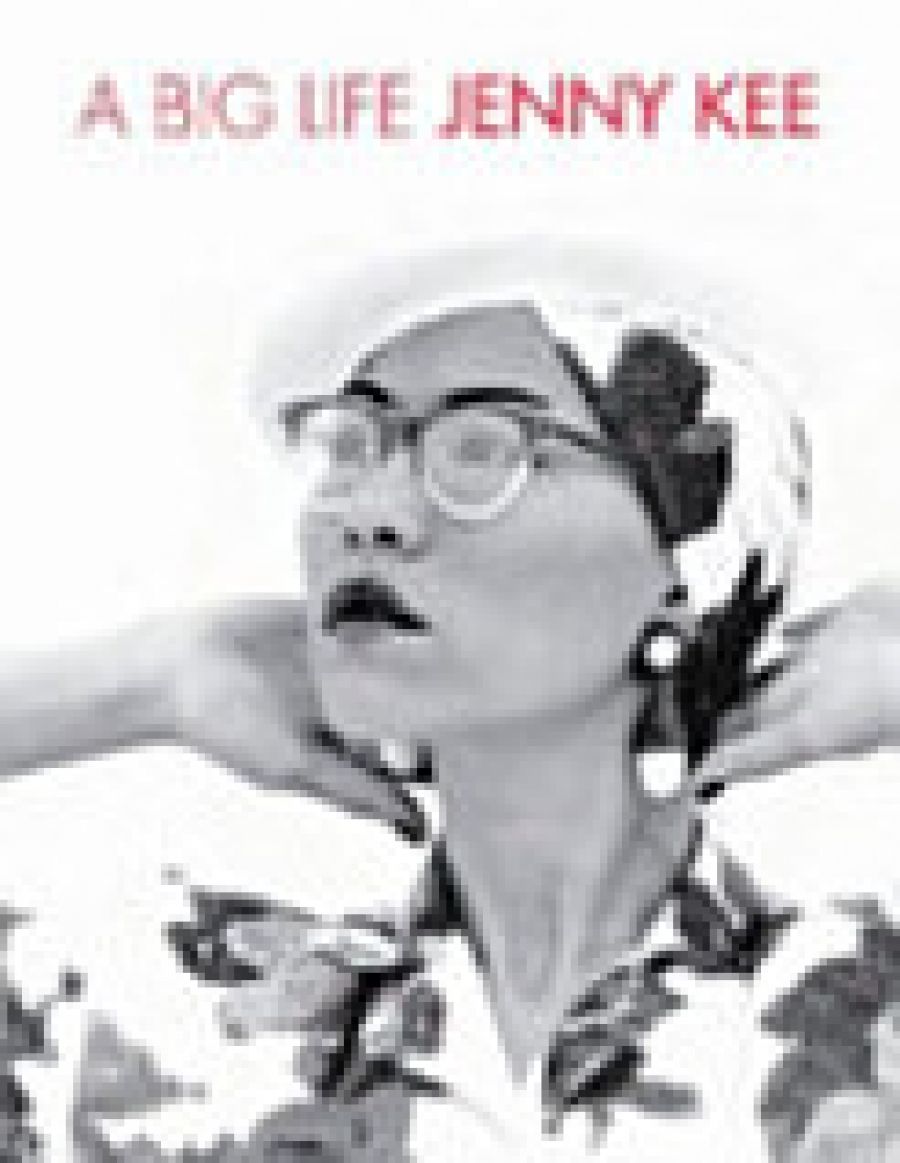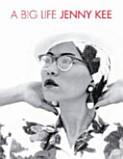
- Free Article: No
- Contents Category: Biography
- Custom Article Title: All about Jenny
- Review Article: Yes
- Article Title: All about Jenny
- Online Only: No
- Custom Highlight Text:
What a big book it is! And so many photographs: only a few without Jenny Kee. The dust jacket is drop-dead gorgeous: just Jenny’s face, with the Revlon red of her trademark glasses and lips lifted to the title. But heavens, this isn’t a dust jacket but a jacket. Take it off. The lining is Jenny’s Monet Opal print, and there are French folds and more photos. Open the book, and here is Jenny’s big life in twelve chapters.
- Book 1 Title: A Big Life
- Book 1 Biblio: Lantern, $59.95 hb, 423 pp, 192098934X
- Book 1 Cover Small (400 x 600):

- Book 1 Cover (800 x 1200):

By the 1960s Jenny was thrilled to be Eurasian: ‘difference was an asset.’ Jenny was crazy about the Beatles. Jenny showed John Lennon how her contact lenses worked. ‘Every girl I knew deceived her mother.’ Jenny walked into a party between Keith Richards and Mick Jagger when the Stones were in Sydney. It’s an ‘endless round of parties’ by now. Then Jenny goes to London, dressed in a paisley-print dress, a ‘peacock blue, slim-fitting, pure silk shift’.
Jenny was a ‘dolly bird’ at Biba. ‘It wasn’t all appearance ... For Biba birds attitude was essential.’ But Jenny has a ‘fashion epiphany’ at Hung On You in Chelsea. Everyone’s there: Eric Clapton and Martin Sharp and Richard Neville and dozens more you’ll have heard of. There’s lots of dope and acid, ‘girls barefoot in the kitchen while the boys changed the world’. Jenny’s boyfriend suicides and there’s ‘strong joints, strong tea’.
Jenny meets Vern Lambert at the Chelsea Antiques Market. Vern’s a ‘fashion obsessive’, a like mind. He’s her professor of fashion and life. Jenny goes home for a holiday. ‘In two years Australia had moved on but not quite as far as I had.’ Back in London, Jenny has sex with the Who’s Roger Daltrey. ‘Popstars [are] the new aristocracy.’ There’s Mandrax and Preludum and dope and acid and opium and more of the new aristocracy than drugs. Jenny ‘flitted about on the periphery’. At a party given by Oz magazine, Jenny wore ‘eucalyptus green crushed-velvet pants, sienna paisley chiffon and a velvet cape, with black boots and loads of Tibetan jewellery ... I looked crash hot.’ Jenny has sex with Eric Clapton.
‘Crashing in and out of love and art, and running on instinct,’ Jenny falls in love with the artist Michael Ramsden. He’s drop-dead gorgeous too: just look at him on page ninety-eight. He saw Jenny’s ‘shyness and insecurity’. Jimi Hendrix shops at Vern’s and then dies. Jenny survives. Robert Hughes is in London too, ‘arrogant, pompous, generous – an upwardly mobile hippie’.
By the 1970s Jenny is back in Australia with Michael, Gough Whitlam is prime minister, and she’s wearing her ‘fifties retro schoolboy look’. Jenny plans her dress salon, Flamingo Park, and meets the immensely talented dress designer Linda Jackson, who ‘lived for her work and let nothing distract her’. By 1975 Jenny’s shop is attracting celebrities like moths to a flame, and Grace is born. Jenny and Linda stage fashion parades. ‘Our passion was fashion,’ Jenny writes, and Gough Whitlam’s government is sacked. Sales continue.
There’s a fire in the Strand Arcade but the Flamingo Park stock is spared. By now, Jenny’s ‘favourite new outfit was my pink Jenny Kee cardie with my caricature round face knitted on the back’. By 1977 Jenny, Michael and baby Grace have moved to the Blue Mountains. Jenny and Grace are on the notorious Granville train that crashes. Eighty-three die, 213 are injured, but Jenny and Grace escape with minor injuries. ‘Within days of the crash I did an interview for Mode’, there’s a fourth parade and six weeks in Milan, Paris and New York. Jenny goes to the big parades, and the Fashionista are swirling around her. Linda Jackson has had a breakdown and is hospitalised, but there will be a fifth parade and dizzy success: ‘My knits were so loud, colourful and graphic ... Linda’s work ... was so serene and mysterious.’
Jenny and Michael fly to Crete and then to Milan: ‘We loved the novelty, the excess – we did it well.’ One day in Milan, Jenny and Michael have a fight and Grace, in between, goes smack into a column. John Lennon is shot that year. Back home, there’s another show. The Power-house Museum purchases some of the clothing and the Art Gallery of New South Wales stages a show of Jenny and Linda’s designs. In 1981 Jenny goes to Lightning Ridge and loves the opals. She paints the iridescent colours, there’s another fight, Michael tears the paintings up, and so the collages of opal designs which became hot-selling sheets and scarves were born. There’s an opal parade. Jenny and Linda, ‘a blazing comet of creativity’, go their own ways.
In New York, Jenny and Diana Vreeland are wearing the same shoes. Jenny is passionate about ‘ethnic style’, producing her Afro-Abo-Oz designs. The question of Aboriginal copyright in respect to tribal motifs leaves Jenny knowing that she is inspired, not plagiarising, and Princess Di is photographed wearing one of Jenny’s koala knits. By 1983 Jenny has a crush on a gay man, Glenn Murcutt has designed the family home, meditation and yoga and environmental activism come onto the scene, and Jenny goes to Uluru and Kata Tjuta Gorge where she gets ‘tears and holes in my shabby-chic designer wear’, and comes home with lots of things. Robert Hughes’s estranged son, Danton, comes to Australia with his mother, Danne. He’s sixteen. Jenny – ‘struck by his beauty’ – ‘was exploring spirituality at the ashram’ and does advertisements for ‘Softly’ washing detergent. Jenny’s now a household name, not just the ‘jumper lady’, and she’s off to Milan and London again. Back at the shop, Jenny’s mum, who takes Christmas seriously, buys presents for everyone, ‘right down to the knitters’.
In Chiang Mai, Jenny has a ‘turning point’. She meets Sudhamma, a Buddhist nun, and Phra Ajahn Pongsak Tejadhammo, who teaches the connection between spirituality and nature, and back at the shop, Lauren Bacall chats to Jenny’s mum. After the Neiman Marcus fortnight in the States, a swirling success and succession of famous names, Jenny returns to Thailand and ‘a shooting star exploded right before my eyes’. Now Jenny gets into Voice Dialogue Therapy, and plays with dolphins at Monkey Mia with Penelope Tree and their daughters. It’s 1988, Australia’s bicentenary, and Jenny takes part in the official ceremony before going to La Perouse to watch the indigenous peoples do their own thing. Jenny is moved. Jenny is alone with her dad when he dies, and she’s completed a mosaic for a new restaurant. Jenny’s business is financially shaky, but she takes ‘solace in therapy’.
It’s now 1990 and Jenny’s marriage is over (remember Michael? Patrick White bought three of his paintings). Wim Wenders has offered Michael his apartment in Berlin, Jenny’s creative juices are flowing again and Danton Hughes comes to stay. He’s twenty years younger than Jenny. They fall in love anyway. Daughter Grace seethes. Danton suffers from depression, and his behaviour is antisocial. ‘I turned down invitations.’ But Danton is at home in the desert and they spend time in Alice Springs. Jenny goes to the States with her Rainforest Forever sheets and then to Milan to see Vern. Back home, she is told that Vern, her mentor, has died: ‘When he died I think the fashion passion in me died too.’ Jenny’s local Blue Mountains community is exploring spiritual growth: ‘voice dialogue, rebirthing, dolphin dreaming, channelling, sand play, shadow play, float tanks, you name it. There should be a medal for sitting in as many circles as I have.’ Then it’s off to India with Danton. Jenny ‘ate thirty toffees for breakfast’ and came home with ‘zillions of new belongings’. In 1994 the shop closes, and Danton’s depression is taking its toll.
Danton is smoking dope again in 1997, Jenny is now an ‘Indiaphile’, doing yoga and enrolled in a Writing Your Life workshop at Varuna, the writers’ centre in the Blue Mountains. Lots of people had told her she should write about her life. She’s now fifty, she’s sold the Murcutt house and Danton has built another. ‘Bliss.’ Robert Hughes visits, opting for a local restaurant rather than Danton’s home: ‘Bob had brought a fine Japanese chisel as a gift, but all Danton had wanted that day was his approval.’ One of Jenny’s cousins writes her a poem. One line reads: ‘She’s met John Lennon, Princess Diana and Danton.’ Jenny goes to London and sees old friends. She designs the Africa and the Americas costumes at the Arrivals segment of the opening ceremony at the 2000 Olympic Games in Sydney. Jenny is happy and dances alone in the centre of the stadium at the close of the extravaganza.
Jenny and Danton have a fight and Jenny travels alone to Byron Bay. On her return, she finds him dead. ‘He’d committed suicide almost eleven years to the day after we’d first made love.’ Jenny describes finding Danton’s body. Now she has an altar with photos of ‘Danton, Mum and my lamas’. She has new Buddhist friends. Sudhamma, the Buddhist nun she’d met in Thailand, tells her to get rid of her trademark red glasses and Jenny does: ‘I was learning to understand the wisdom of ordinariness.’
Jenny Kee wrote A Big Life with Samantha Trenoweth. ‘I trusted you Sam, and knew I could tell my story to you completely – so crucial for if I was to write my autobiography it had to be honest. I talked and you typed and interpreted.’ Jenny tells us that Danton laughed out loud when he read the first chapters. ‘Jen, you can really write!’


Comments powered by CComment